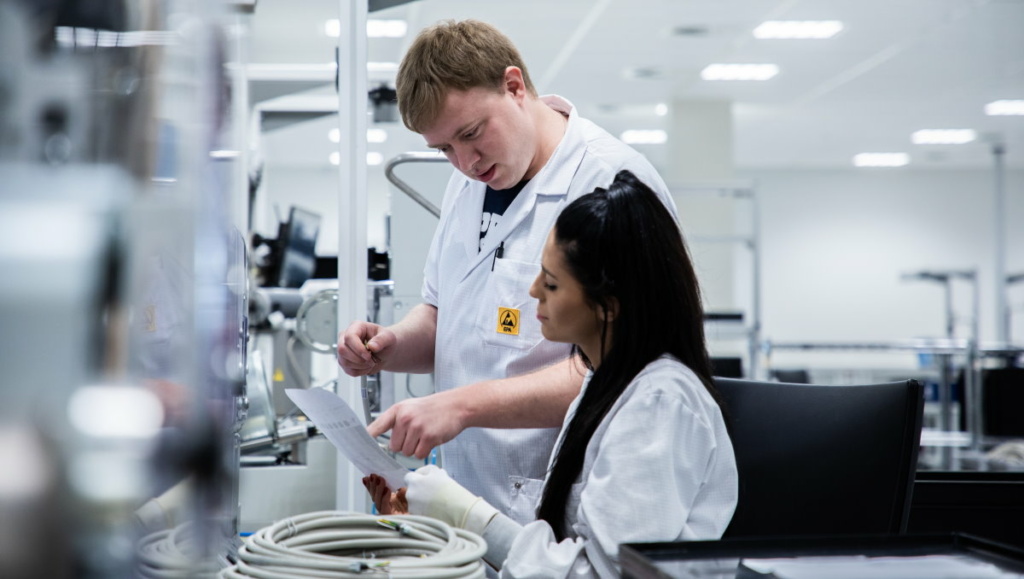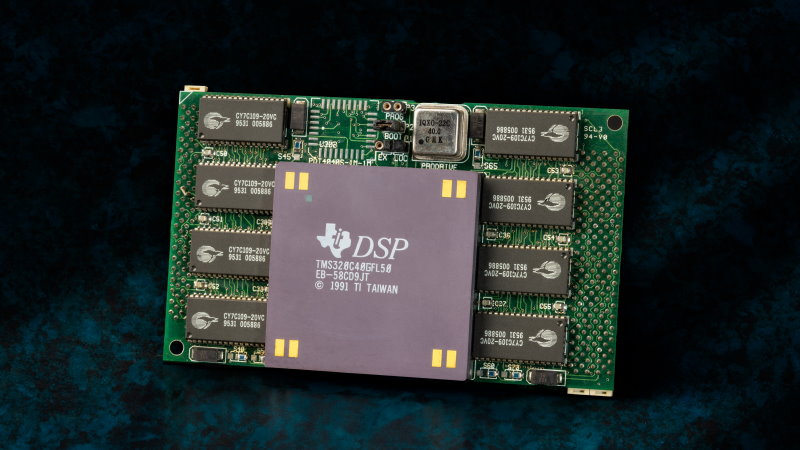
“We have some stubborn engineers, and so have they”
The collaboration between ASML and Prodrive Technologies goes way back. Just after Pieter Janssen and Hans Verhagen started their company in 1993, still operating from its initial premises at Eindhoven University of Technology, engineers from the neighboring lithography specialist dropped by. “They were interested in our DSP technology,” recalls Janssen. In those days, electronics for motion applications were still very much focused on analog solutions, but that technology reached its limits for the advanced motion control ASML was aiming for. “Our digital signal processing technology caught their eye. The ultrafast control loops and the high sample rates that ASML needed in the control of their wafer stages could be realized with our DSPs.”
That initial meeting proved to be the starting point of a fruitful collaboration, says Janssen. “We were selected as the preferred supplier for motion electronics to control the stages of the illustrious PAS 5500 machines.” At first, Prodrive outsourced the production to a third party, but later on, it pulled production in-house, as the relationship with ASML grew stronger and its business developed.
After that first project, many more followed. “We started Prodrive around the idea of combining digital technology with power electronics,” explains Janssen. “A logical next step was to provide ASML with power electronics to drive their motors.” One research project that Janssen looks back to fondly concerns the start of what is now the ASML short-stroke amplifier, which greatly determines the accuracy of the high-precision machines from Veldhoven.
Stubborn engineers
After the boards came the modules, which developed into complete racks of control electronics. “Driven by the needs of ASML, we took more responsibility upon ourselves,” says Leon van de Laar, Prodrive veteran and currently business development manager. “Every year, their machines have to evolve, get better, move faster. Design groups within ASML challenged us – and they still do today. To come up with ideas, to solve their issues, within the boundaries they set. Together, we try to find the optimal solution.”
Van de Laar admits that discussions can get heated. “We have some stubborn engineers, and so have they. But you need to argue sharply to find the best answers to your problem. It’s the Dutch approach of course, and one of the reasons that ASML is so far ahead of the rest.” Janssen adds: “Prodrive is doing business all over the world, but nowhere have I seen this level of collaboration where a company is pulling a whole ecosystem.”

Confidence
The outsourcing model ASML has created is based on trust and openness. “I applaud them for being as open as they are,” says Van de Laar. “Key suppliers such as Prodrive are getting involved very early on in the design cycle. ASML has a strong track record in supplier days and technology conferences where they inform their supply base extensively of their plans, their needs and their bottlenecks, and they challenge you to come up with solutions. Being so open radiates confidence in their suppliers.”
Being in the ASML ecosystem also means that Prodrive has to step up. “They expect the highest levels of performance, in all aspects. In development, in delivery, in quality, in competitiveness,” Van de Laar sums up. “You can really distinguish yourself when you score high on R&D. I think that’s something Prodrive excels at. And we won’t shy away from proposing a specific, promising route that might be more risky. That entrepreneurship is the base of our organization.”
Re-use
As ASML is pushing the envelope in its supply chain, Prodrive and other partners have to comply with other regulations as well, for instance in traceability. That comes in very handy now that ASML is raising the bar in sustainability. “Sure, throughput and uptime are still the most important KPIs,” says Janssen. “But more and more focus is put on keeping all the existing systems running and extending their lifetime.” ASML’s Mature Products & Systems division is buying back older machines, at the moment mainly PAS 5500 systems, and refurbishes them for a new life at chip fabs where shrinkage isn’t the name of the game. Also, machines in the field are upgraded with the latest electronics cabinet configurations.
Prodrive supports ASML in that track. “For electronics, aging is a serious issue,” Van de Laar explains. “For starters, because electronic components degenerate over time. After a certain amount of time, they have to be replaced. ASML has a whole system in place to service all its machines and avoid downtime as much as possible.”
Obsolete components
Another issue is the availability of the components that were chosen as far back as thirty years ago. “Many have become obsolete, which can be a huge problem,” Janssen points out. “But due to the good traceability of the systems and components that were sold, we know beforehand what to expect from returned electronics. And we have the engineering power to quickly redesign the boards with modern components. As we develop and manufacture many more products and systems with long lifetimes for other clients as well, this capacity is inherently part of our business anyway. A real advantage as well during the last period of shortages.”
Isn’t it complicated to change components in an ASML machine, since usually many stakeholders have to approve modifications in the design? “It depends,” answers Van de Laar. Prodrive is partnering with ASML on many levels and within different business models. “For some products, the technical responsibility lies completely at Prodrive, so we’re free to make adjustments, provided we stay within the qualifications that ASML has approved. In these cases, we can operate relatively autonomously. Other products ASML has kept in their own hands. There, we can only advise what update we think is best.”
Smaller footprint
The technology Prodrive develops for ASML can be beneficial for other customers and vice versa. Janssen: “For other customers, in other markets, we use technology that’s derived from developments at ASML. Also, things we design and manufacture for other customers can be mapped back to ASML. To give an example, we build gradient amplifiers for the medical industry and big power systems for hydrogen applications. A lot can be re-used in ASML products. In the early days, all that mattered for ASML was functional innovation, but other features like cost, manufacturability, power consumption and quality are becoming more dominant with every generation. So the knowledge we gain from other clients we can apply in our newest ASML designs.”
Footprint is one such feature that’s getting more attention than before. “An important part of our collaboration with ASML evolves around power electronics for motion control, in the DUV, NXE and EUV platforms,” says Sam de Bruijn, director of account management at Prodrive. “Recently, we developed a new concept for the power cabinets. The old platform has been in place for about ten years, gradually evolving with new innovations. However, a new platform was necessary, one that can be used for another ten years or so.”
One of the biggest advantages of that new platform is the density. “We’ve raised the efficiency resulting in capturing the same amount of power on a smaller footprint, within a highly scalable and flexible solution,” De Bruijn explains. “You need a platform you can build on because you can’t start from scratch every time and spend the next four years developing that power cabinet. Now we’ve set the base to follow ASML’s roadmap for many years to come.”
Janssen concludes: “We’ll keep challenging each other, reaching higher goals, through intimate and open collaboration and respecting and trusting each other’s strengths and abilities.”
Main picture credit: Prodrive Technologies





